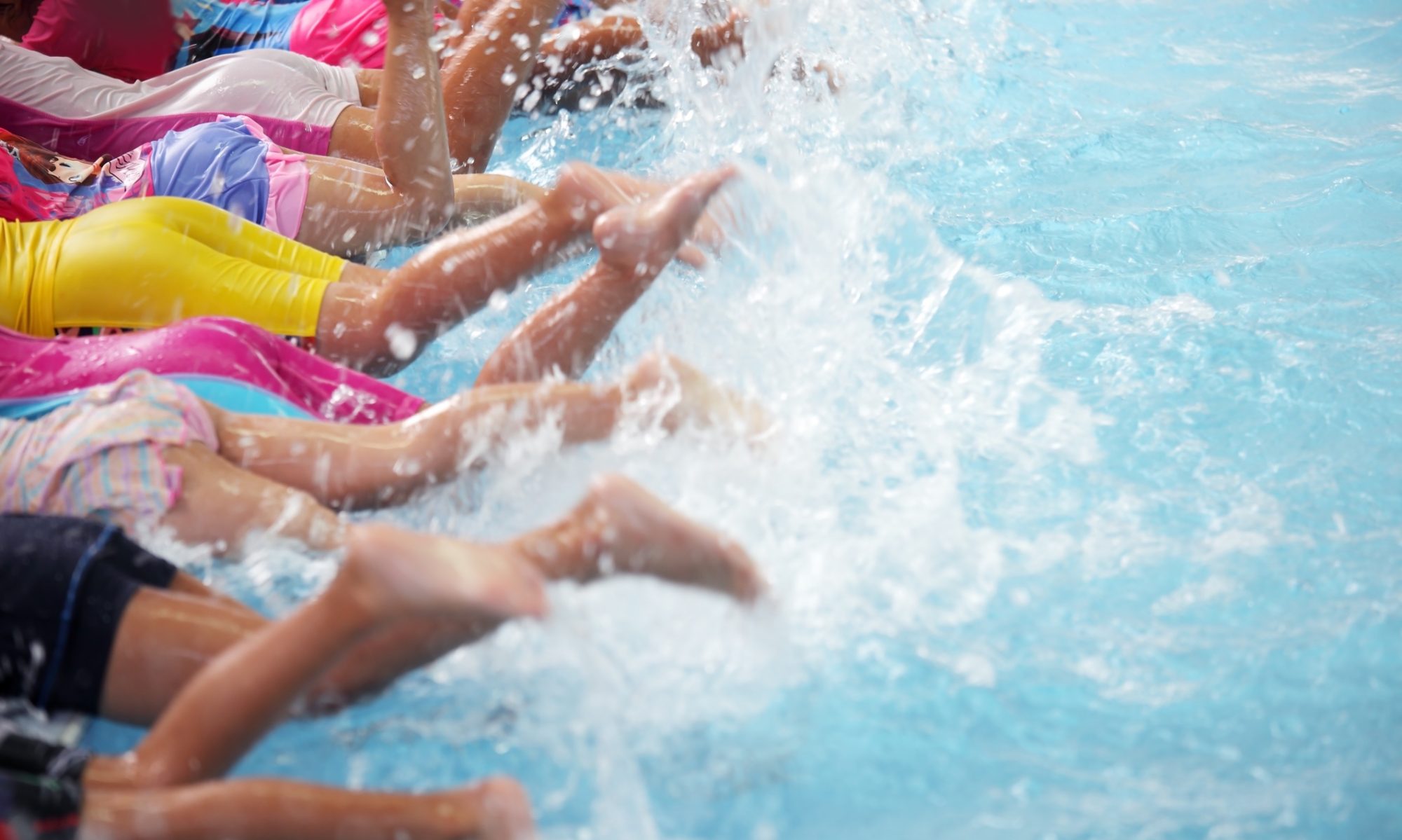Find out about our badge scheme.
We follow the STA’s international learn to swim programme, which we use as a guide for your child’s progression through the swim school. We love the STA scheme as it gives us flexibility on where to place your child, so the sole focus isn’t on getting their badge for a particular stage, but making sure they’ve developed each swimming stroke well. If a child is doing really well, we can also award them a higher badge to show you and your child how much they’ve come on.
Even though we think the badges we have are great, our focus is on swimming and enjoyment rather than just ticking each badge off through the swim school. If you want to find out more about each badge and what it involves, check out the descriptions below. These badges are the core of the STA learn to swim program, but we may use alternative badges that are more appropriate for your child.

STA badge scheme
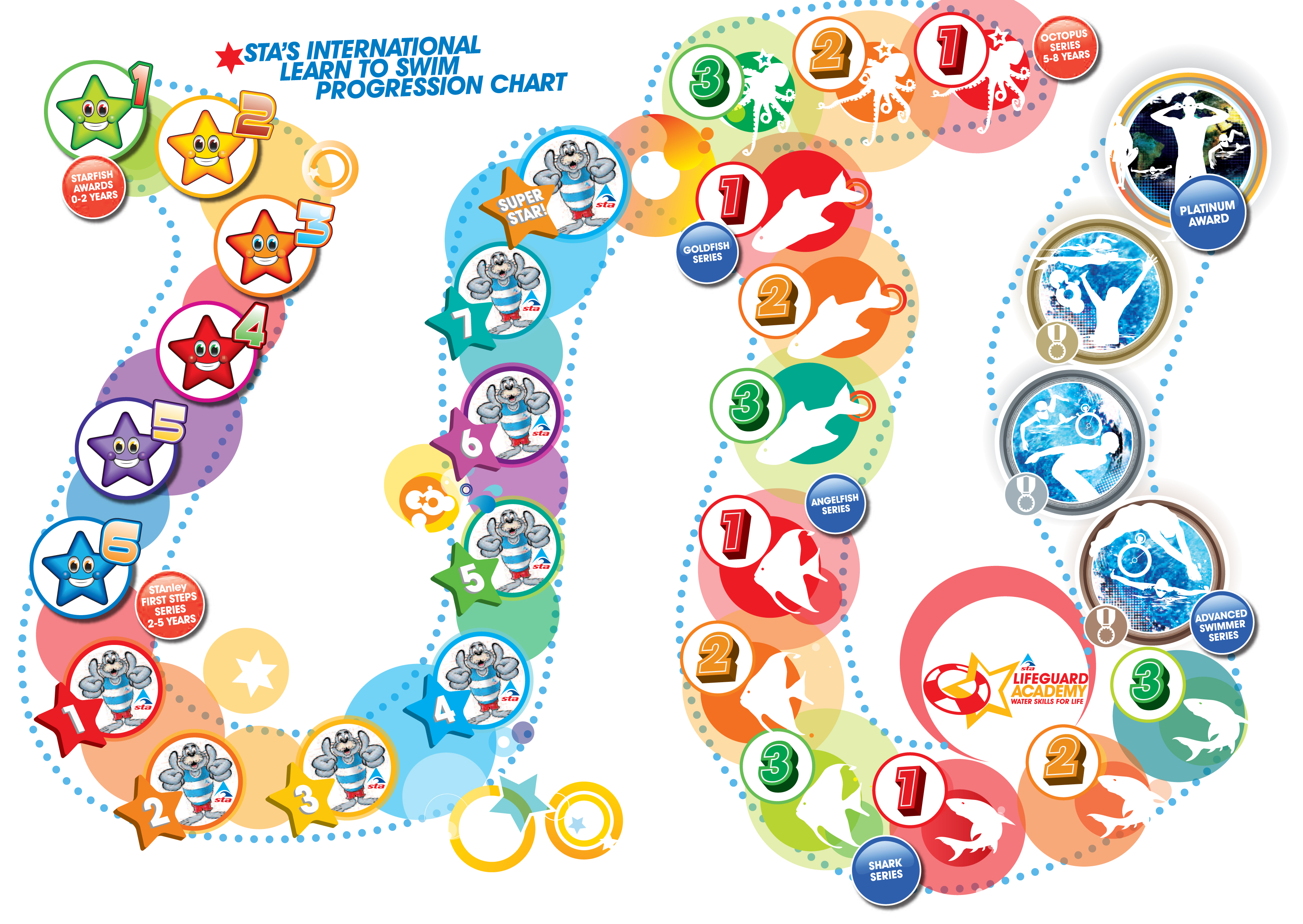
Stanely First Steps
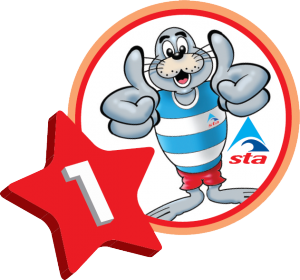
A child’s first learn to swim experience is one of the most important in terms of capturing and retaining their interest. We believe the best way to achieve this is to create safe environments in which children can be introduced to the water whilst having fun and by providing a progressive learn to swim programme that is both challenging and rewarding.
This series culminates with the STAnley Star award, which covers all the skills in the 7 awards, ensuring that the learner is competent and confident in and around water.
The STAnley awards 1-5 covers Swim England’s Stages 1-3.
Tell me more
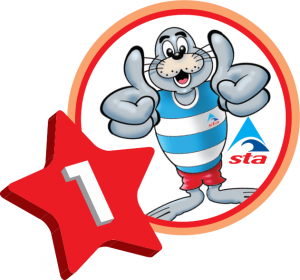
Learning Outcomes
- Identify the teacher
- Enter the water safely
- Splash feet at water’s surface while supported by wall/ woggle/adult and then return to a standing position
- Walk forwards, backwards and sideways through the water unaided for 5 metres.If in deeper water, unassisted walking actions may be substituted
- Move through the water on the front for 2 metres, turn around and move back to start position
- Move through the water for 2 metres on the back, roll to regain feet.
- Blow a small object across the pool for 2 metres
- Travel under a woggle bridge and through a shower created by a watering can
- Push and glide on the front
- Exit pool safely
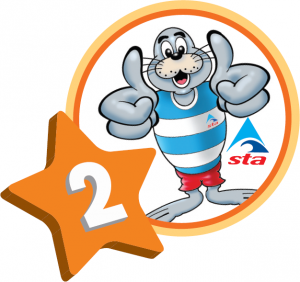
Learning Outcomes
- Show an understanding of poolside safety
- Enter the water safely from the poolside
- Blow bubbles into the water, with mouth or nose and mouth submerged
- Move through the water for 2 metres on the front while blowing bubbles, return to an upright/standing position
- Move through the water for 2 metres on the back using an alternating leg action, ears in water and return to an upright/standing position
- Perform a star floating position on front or back
- Use front paddle action to move a ball across the pool
- Push and glide on the back
- Roll from front to back, looking at the ceiling
- Climb out of the pool safely
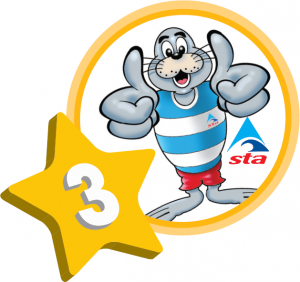
Learning Outcomes
- Answer a question on poolside safety rules
- Enter the water from poolside, move forward 1 metre, then return and exit the pool unassisted
- Blow bubbles into the water with face submerged
- Perform a star float while on the back and regain the feet
- Move through the water while on the back, using an alternating leg action for 5 metres
- Move through the water 5 metres on the front, using front paddle action
- Complete a 360° turntable with feet off the pool floor
- Roll from back to front and return onto the back
- Jump or step into the water from poolside with hand support from a swimming teacher or assistant
- Show treading water action with legs on woggle – (seahorses)
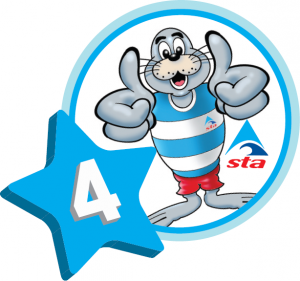
Learning Outcomes
- Answer 2 questions on poolside safety
- Swim 5 metres of front paddle, roll onto back and swim 5 metres on the back
- Bob up and down, submerging the face 4 times, exhaling underwater
- Pick up an object from below the water surface
- Perform 2 float positions, which may be in a sequence and performed on the front or the back
- Push and glide on back, tuck and roll forward to return to poolside
- Tread water, using arms and legs
- Attempt a circular action of either arms or legs
- Jump or step into pool safely unaided
- Climb out of pool safely unaided
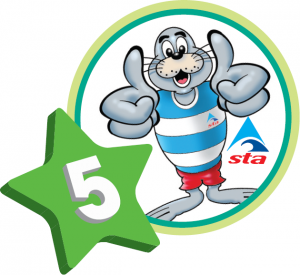
Learning Outcomes
- Answer 2 questions on poolside rules
- Swim 2 metres of front paddle or back paddle, without support
- Hold 3 different types of floating positions, each for 3 seconds
- Breathe rhythmically for 4 cycles, either supported or moving
- Jump or step in from poolside, tread water, turn and swim back to poolside
- Push off on the back and kick with a simultaneous leg action for 5 metres using a woggle or float
- Perform a push and glide on the front, keeping the face in the water and blowing bubbles
- Retrieve an object from bottom of pool
- Demonstrate front crawl arm action
- Demonstrate back crawl arm action
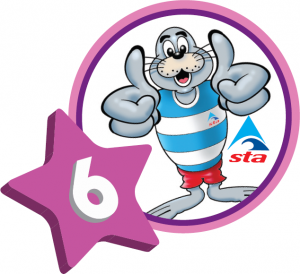
Learning Outcomes
- Answer 2 water safety questions
- Push and glide on the back, arms by side, ears in water
- Swim through a submerged hoop
- Swim 3 metres on front using a breaststroke type leg action, holding 2 floats or woggle
- Swim 2 metres on the front and 2 metres back, paddle with a smooth transition in between (log roll)
- Step, star or pencil jump into the pool, tread water then return to poolside
- Hold the side of the pool and push off on the side under water
- Swim on the front, tuck up and return swimming on the back
- Swim 5 metres of either front crawl or back crawl
- Scull forwards, backwards or in a circle, using a woggle
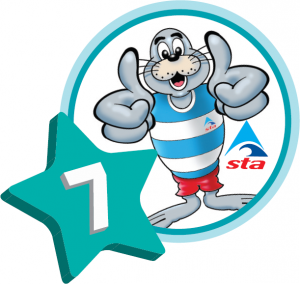
Learning Outcomes
- Answer 3 water safety questions
- Perform a star float, slowly change to a narrow float and return to a star float on either the front or back
- Push and glide on back with arms stretched then roll onto front
- Swim 2 metres, dolphin leg kick on the front or back
- Tread water for 10 seconds
- Swim 5 metres using a frog breaststroke type action of the arms and legs
- Swim 10 metres of front crawl confidently, attempt side breathing
- Swim 10 metres on the back confidently
- Swim through a submerged hoop and retrieve an object
- Scull/scoop head first ,using a woggle, and arms only
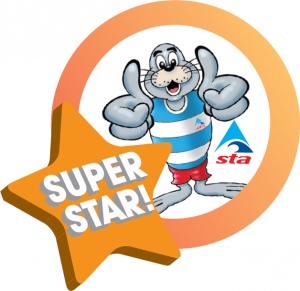
Learning Outcomes
- Answer 4 water safety questions
- Push and glide into a confident 10-metre swim
- Push and glide or swim, travel through a submerged hoop, retrieve an object, and return to poolside
- Use a float and kick on the front to collect 4 floating objects that are scattered around the pool. Return to poolside
- Swim 2 metres on back, rolling over horizontally to swim 2 metres on front, rolling over horizontally to finish with a back star float
- Push and glide from poolside on the back and kick for 2 metres, tuck up and roll forward on the vertical to swim back to poolside
- Kick for 5 metres on the back, balancing a toy on a float
- Jump into the water, swim to a raft (play raft) and climb onto it to sit down
- Jump into the water, tread water while turning around, swim back to poolside
- Exit the pool safely – over the poolside if possible or as the pool environment dictates – and continue off poolside to changing room
Show less
Octopus Series

This enables older children to access the Learn to Swim pathway and develop their confidence, knowledge and skills. We believe the best way to achieve this is to create safe environments in which children can be introduced to the water whilst having fun and by providing a progressive learn to swim programme that is both challenging and rewarding.
On completion of the Octopus series, learners can progress through the Learn to Swim journey and move on to the Goldfish, Angelfish and Shark series. A child’s first learn to swim experience is one of the most important in terms of capturing and retaining their interest.
The Octopus 1 and 2 awards are similar to Stages 1 and 2 Swim England awards.
Tell me more

Learning Outcomes
- Answer 2 water safety questions
- Enter the pool safely, steps, ramp, swivel
- Move through the water confidently in different ways – walk, hop, jump, skip, gallop, march
- Use a woggle to swim front paddle and back paddle for 5 metres
- Push and glide on the front and back
- Attempt a simultaneous circle action with legs while on the back for 2 metres, using a woggle or floats
- Travel under a woggle waterfall, experiencing water over the head
- Return to standing from a star float on the back
- Perform a treading water action with legs using a woggle (sea horses), or floats
- Exit the pool safely and unassisted

Learning Outcomes
- Answer 2 water safety questions
- Enter the pool safely with a step or jump
- Swim 2 metres of front paddle, and 2 metres of back paddle, unaided
- Use a woggle to kick across pool while blowing bubbles
- Demonstrate front crawl arm action while standing
- Demonstrate back crawl arm action while standing
- Push and glide on the front with face in the water
- Push and glide on the back arms by the side
- Rotate from back float to front float, and return back to a back float, using a woggle
- Submerge under water and retrieve an object

Learning Outcomes
- Answer 2 water safety questions
- Enter the water with a step or jump entry, turn around and swim back to poolside
- Push and glide into either front crawl or breaststroke for 5 metres
- Push and glide into back crawl, and swim for 5 metres
- Perform a star float on the front or back, and hold for 3 seconds
- Perform dolphin leg kick on the front or back for 2 metres
- Scull head first, using a woggle
- Attempt breaststroke – may use a woggle for support
- Tread water for 10 seconds
- Swim forward for 2 metres and then roll onto back, swim on the back for 2 metres and roll into a standing position (regaining feet)
Show less
Goldfish Series

This programme is designed to be the next stage for your child when they have progressed through either the STAnley First Steps Series or Octopus Series.
The Goldfish series is an exciting series of 3 progressive awards expanding on skills in a fun, progressive, challenging and rewarding way.
On completion of this series, your child will be able to swim 15 metres without any aid as well as perform basic floats.

During this award series, your child won’t be wearing buoyancy aids.
If your child needs buoyancy aids, we will find an award more appropriate to them.
Tell me more

Learning objectives
- Answer 2 water safety questions
- Enter the water with a step or jump entry, tread water for 5 seconds, swim to poolside
- Push and glide, and hold the streamlined position for 5 seconds
- Push and glide, or swim to the bottom of the pool, to retrieve an object
- Swim 5 metres on front, roll over and swim 5 metres on back
- Perform dolphin leg kick on the front or back for 5 metres
- Scull head first for 2 metres
- Scull feet first, using a woggle for support
- Show rhythmical breathing in front crawl for 10 metres, using a woggle or float
- Swim a recognisable breaststroke for 5 metres

Learning objectives
- Answer 2 water safety questions
- Perform a back float, tuck to a front float and return to a standing position
- Scull head first for 5 metres, and feet first for 3 metres
- Push and glide on the back, tuck, rotate to the front and return to the starting point
- Swim 10 metres of a recognised front stroke, either front crawl or breaststroke. Learner’s first choice
- Swim back crawl for 10 metres
- Swim 5 metres of a recognised front stroke. Learner’s second choice
- Push and glide to the bottom of the pool, tuck, place feet on the bottom and spring up
- Perform a mushroom float and hold for 3 seconds, extend to a front float and return to a standing position
- Enter the water with a step or jump entry, swim 5 metres on the front, then swim to poolside and exit water safely
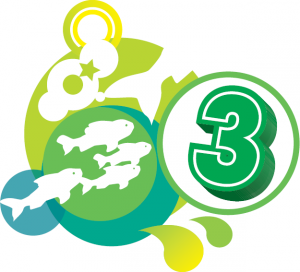
Learning objectives
- Answer 2 water safety questions
- Perform 2 different types of entries and tread water for 15 seconds each time; performed in shoulder-deep water
- Swim 15 metres of back crawl
- Swim 15 metres of a recognised front stroke, either front crawl or breaststroke
- Swim 10 metres, holding a float under each arm, using lifesaving backstroke leg kick
- Swim 5 metres, dolphin leg kick on front
- Swim 5 metres, dolphin leg kick on back
- Perform a handstand with both hands on the pool floor; performed in chest-deep water
- Perform a horizontal float on the back and hold for 5 seconds, roll on to the front, hold for 5 seconds, roll to the original back float position and hold for 5 seconds
- Submerge, push and glide on the side, roll to a face down position
Show-less
Angelfish Series

This award series prepares your child to swim 25m without aid, perform butterfly stroke as well as mastering sculling techniques and entries to the water. Your child will also start to learn Butterfly here, if they haven’t done so already.

During this award series, your child won’t be wearing buoyancy aids.
If your child needs buoyancy aids, we will find an award more appropriate to them.
Tell me more

learning objectives
- Be rescued by a reaching aid
- Perform a straddle entry and tread water for 30 seconds. If the water is too shallow, substitute step entry and support scull for 30 seconds.
- Push and glide into a forward somersault
- Scull head first for 5 metres and feet first for 5 metres
- Swim 15 metres of a recognised front stroke with correct breathing. Learner’s first choice
- Swim 10 metres of front stroke with correct breathing. Learner’s second choice
- Swim 20 metres of back crawl
- Swim 10 metres on the front, using dolphin leg kick, without aids
- Start in a crouch position in the water, spring up before gliding to bottom of pool, then glide to surface
- Swim 5 metres of lifesaving backstroke without aids

learning objectives
- Be rescued by catching a buoyant aid
- Perform a straddle entry, tread water for 30 seconds, perform a 360° turn in a vertical position while wearing a T-shirt. If the water is too shallow, substitute step entry and support scull for 30 seconds and a 360° turn in a vertical position while wearing a T-shirt
- Swim 5 metres, perform a forward somersault and continue to swim forward for 5 metres
- Swim 20 metres of a recognised front stroke using a correct touch finish. Learner’s first choice
- Swim 15 metres of a recognised front stroke using a correct touch finish. Learner’s second choice
- Swim 20 metres of back crawl using a correct touch finish
- Swim 5 metres on the back using a double arm action and dolphin leg kick
- Swim 5 metres on the side using a dolphin leg kick
- Start in a crouch position in the water, spring up before gliding to the bottom of the pool, tuck, place both feet on the bottom of the pool and spring up. Perform in chest-deep water
- Swim underwater for 5 metres
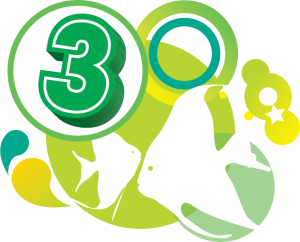
learning objectives
- Be rescued by catching a rope
- Perform a straddle entry and tread water for 30 seconds while wearing a T-shirt. Remove the T-shirt and climb out unassisted. If the water is too shallow, substitute step entry and support scull
- Perform a head-first and feet-first surface dive. If in shallow water, perform an underwater push and glide to pool floor
- Scull feet first for 10 metres and head first for 10 metres
- Swim 25 metres of back crawl using a correct finish
- Swim 25 metres of a recognised front stroke, incorporating a correct finish. Learner’s first choice
- Swim 20 metres of recognised front stroke, incorporating a correct finish. Learner’s second choice
- Swim 5 metres of butterfly
- Push and glide into a handstand – must be performed in tummy-deep or to chest-deep water
- Perform a sitting dive, depending on the depth of water. If in shallow water, perform underwater push and glide, roll onto back while underwater and surface in a back glide
Show less
Shark Series
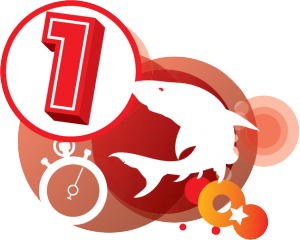
This series educates your child in basic water rescue and survival techniques as well as starts and turns for each of the strokes. On completion of the series, your child will also be able to swim 100 metres.
Tell me more
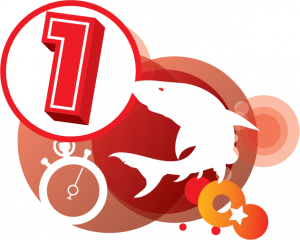
learning objectives
- Perform a shout and signal rescue to a weak swimmer, 5 metres away
- Enter the water with a slide-in entry, swim 10 metres in a T-shirt, tread water for 30 seconds, remove T-shirt, and climb out
- Swim 5 metres of a recognised front stroke, perform a head-first surface dive and swim 5 metres underwater
- Swim 5 metres of a recognised front stroke, perform a feet-first surface dive, tuck, and swim 5 metres underwater
- Swim 50 metres of a recognised front stroke. Learner’s first choice
- Swim 50 metres of back crawl
- Swim 25 metres of a recognised front stroke. Learner’s second choice
- Swim 25 metres of Old English backstroke
- Swim 25 metres of front crawl, demonstrating bilateral breathing
- Perform a kneeling dive, depth of water permitting. If in shallow water, perform underwater push and glide for 5 metres

LEARNING OBJECTIVES
- Perform a reaching rescue to a casualty up to 2 metres from the side
- Throw a buoyant aid 3 metres to a target point in the pool
- Enter the water with a step-in entry, swim 10 metres of a recognised stroke in a T-shirt and shorts, tread water for 1 minute, swim 5 metres of a recognised stroke, surface dive, swim 3 metres underwater, surface, climb out of the pool unassisted
- Swim 75 metres during which the learners perform 3 recognised strokes with a smooth transition and the correct turns
- Scull head first for 20 metres
- Swim 10 metres of butterfly
- Swim 20 metres of side stroke, wearing a T-shirt and shorts
- Perform a plunge dive, swim width of pool or 7 metres, depth of water permitting. If in shallow water, submerge and push and glide on your side, roll onto the back and return to the surface with dolphin leg kick
- Swim 4 x 1 width of individual medley, incorporating the appropriate transition procedure at the end of each stroke
- Perform a backwards somersault
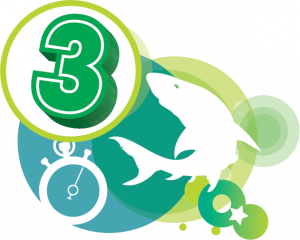
LEARNING OBJECTIVES
- Throw a rope over 5 metres
- Enter the water with a straddle entry, swim 25 metres in a recognised stroke in a T-shirt and shorts, tread water or scull support for 1 minute, tread water for 1 minute waving one arm, surface dive, swim 5 metres underwater, surface and remove clothing. If in shallow water, substitute straddle jump for step- in or slide-in entry
- Swim 100 metres of a recognised stroke on the front, incorporating the appropriate start, turns, and finish. Learner’s first choice
- Swim 50 metres of a recognised front stroke, incorporating the appropriate start, turns and finish. Learner’s second choice
- Swim 100 metres of back crawl incorporating the appropriate start, turns and finish
- Swim 25 metres of a fourth recognised stroke, not undertaken in the other tests
- Swim 4 x 1 length of individual medley, incorporating the appropriate transition procedure at the end of each stroke
- Perform a competitive start for two separate strokes using two different stances that is legal for the depth of water available
- Swim 50 metres of side stroke or old English backstroke
- Perform a head-first surface dive and pick up a sinkable toy from the bottom of the pool, minimum depth of 1.5 metres
Show less
